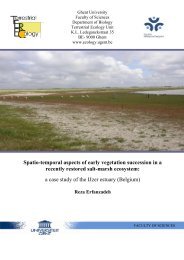PhD Arthur Decae 2010 - Ghent Ecology - Universiteit Gent
PhD Arthur Decae 2010 - Ghent Ecology - Universiteit Gent
PhD Arthur Decae 2010 - Ghent Ecology - Universiteit Gent
Create successful ePaper yourself
Turn your PDF publications into a flip-book with our unique Google optimized e-Paper software.
genera are classified in the subfamily Nemesiinae (Raven 1985) and they represent the<br />
western most taxa of a more or less continuous Palaearctic longitudinal distribution range<br />
running from the Pacific in the East to the Atlantic in the West (see Chapter 5). They are<br />
absent from the northern permafrost affected regions of Eurasia indicating a low dispersal<br />
capacity when compared with Atypus. The Mediterranean diversity at the genus level is fully<br />
restricted to regions that originated in the Neoeuropean Archipelago (Figs. 2-5) and only the<br />
genus Nemesia has one species (N. cellicola Audouin 1826) on the African continental plate.<br />
The general Palaearctic longitudinal diversity pattern of Nemesiinae is continued within the<br />
Mediterranean Region with Raveniola in eastern Anatolia (Fig. 2), Brachythele in<br />
southeastern Europe (Fig. 3) and Iberesia in the western, Atlantic regions (Fig. 4). Only<br />
Nemesia has a much broader Mediterranean distribution running from the Atlantic coast to the<br />
eastern Mediterranean. Nemesia has a very different pattern of diversity in the western and<br />
eastern parts of its distribution range that reflects palaeogeographic configurations in its<br />
present distribution rather than the present geography (Chapter 5). A strong positive effect on<br />
building Nemesia diversity should therefore be attributed to situations of geographical<br />
fragmentation and isolation during the millions of years of existence of the Neoeuropean<br />
Archipelago. The idea that Nemesiidae in Europe have been repeatedly ‘pushed back’ into<br />
small fragmented and isolated refuge populations in a series of Pleistocene glaciations, and<br />
that these ongoing cycles of fragmentation and isolation have lasted sufficiently long for<br />
further diversification and speciation cannot be ruled out however. Thorough species level<br />
revision of all nemesiid genera is needed to clarify these propositions.<br />
Cyrtauchenius<br />
Raven 1985 grouped the genera Cyrtauchenius and Homostola in an all African subfamily<br />
Cyrtaucheniinae, with a disjunct distribution to the North and South of the tropics (Fig. 6<br />
inset). Tropical African cyrtaucheniids are placed in another subfamily, Aporoptychinae,<br />
together with the Australian and American taxa. The Asian genus Anemesia (WSC Platnick<br />
<strong>2010</strong>) is probably wrongly placed in the Cyrtaucheniidae and should be moved to Nemesiidae<br />
(probably genus Raveniola). The grouping with Homostola of Cyrtauchenius suggests an<br />
African origin of the Mediterranean cyrtaucheniids. From biogeography this seems difficult to<br />
explain and from this perspective the Cyrtaucheniinae are expected to be paraphyletic. On the<br />
other hand however the Mediterranean cyrtaucheniids have clearly southern affinities,<br />
although the comparatively high species diversity seems to be related to a long history of<br />
fragmentation and isolation of populations in the western Neoeuropean Archipelago. A<br />
problem with the interpretation of the currently known distribution of Cyrtaucheniinae is the<br />
complete absence of information from sub-Saharan North Africa and from southwestern<br />
Africa. Information on the mygalomorph fauna of the Sahel region is expected to aid<br />
importantly to the information presented here.<br />
Ummidia<br />
The Mediterranean Ummidia population is revised in Chapter 6. It was found to contain at<br />
least four species all distributed in the Iberian-Maghreb region (Fig. 7). Traditionally<br />
Ummidia is grouped with Conothele in the subfamily Ummidiinae (formerly Pachylomerinae)<br />
with a remarkably wide distribution in the Northern Hemisphere and the Indo-Australian<br />
Region. In the revision presented in Chapter 6 Ummidia and Conothele are placed in<br />
synonymy in which the name Ummidia has priority. Ummidia therefore has an almost<br />
worldwide distribution, mainly although not entirely north of the equator. The East Asian<br />
genus Latouchia probably is the closest living relation of Ummidia (personal observation).<br />
The Mediterranean Ummidia population appears to be a remnant of a much wider European<br />
distribution as is evidenced by the finding of fossil Ummidia specimens in Baltic amber










